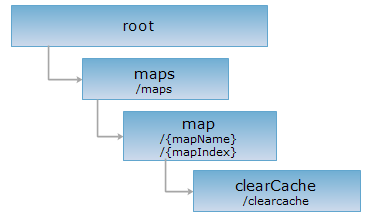<map_uri>/clearcache[.<format>]
ERROR: Variable (map_link) is undefined.
The clearCache resource is an algorithm resource for clearing the map cache, which can be realized by implementing the GET request on the URI with parameters included. The request parameters must be put in the URI.
Supported methods
Supported output formats: rjson, json, html, xml.

Implement the HTTP request on the following URI and return the response in rjson format. In the URI below, supermapiserver is the name of the server, and WorldMap is the map name (mapName).
http://supermapiserver:8090/iserver/services/map-world/rest/maps/WorldMap/clearcache.rjson
Clears the map cache. The request parameters must be put in the URI.
Parameters need to be included in the URI when implementing the GET request on the clearCache resource are as follows:
| Field | Type | Definition |
| bounds | Rectangle2D | Required. The bounds of the cache to be cleared. |
Implement the GET request on the clearCache resource and get the response indicating whether the clear cache operation is successful, that is, "true" or "false".
Implement the GET request on the clearCache resource with http://supermapiserver:8090/iserver/services/map-world/rest/maps/WorldMap/clearcache.rjson?bounds={"rightTop":{"y":120,"x":120},"leftBottom":{"y":0,"x":0}} and get the response in rjson format, as shown below:
true
Asks for the response identical to the one that would correspond to a GET request, but without the response body. This is useful for retrieving meta-information written in response headers, without having to transport the entire content. The meta-information includes the media-type, content-encoding, transfer-encoding, content-length, etc.
The HEAD request helps check the existence of the entireImage resource and whether it can be accessed by the client. By implementing the HEAD request on the URI, with .<format> appended to the end, we can quickly get to know whether the entireImage resource supports the representation in <format> or not.